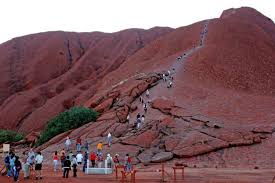Saturday, October 12, 2019
 Huge numbers of tourists are going to Uluru. Also known as Ayers Rock, before an impending ban on climbing this sacred site to indigenous Australians has become important. Several photographs showing hundreds of people clambering up the monolith have incited a social media reaction, with critics lashing as “ignorant” those going against the wishes of the traditional Aboriginal owners of the land, the Anangu.
Huge numbers of tourists are going to Uluru. Also known as Ayers Rock, before an impending ban on climbing this sacred site to indigenous Australians has become important. Several photographs showing hundreds of people clambering up the monolith have incited a social media reaction, with critics lashing as “ignorant” those going against the wishes of the traditional Aboriginal owners of the land, the Anangu.
“A mass of morally and ethically bankrupt people,” indigenous woman Laura McBride tweeted next to an image showing many people climbing up the side of Uluru. “One even hiking a toddler up, teaching the next generation how to be ignorant.”
“Imagine rushing to climb Uluru before it closes just so you could brag about disrespecting the oldest living culture in the world,” tweeted National Indigenous Television journalist Madeline Hayman-Reber, who called the scenes “embarrassing”.
According to the officials, the ban will come into effect on October 26. It is intended to show some respect for cultural practices, defend the site from environmental harm and to make sure the safety of the visitors. In the 12 months to June 2019, over 395,000 people visited the Uluru-Kata National Park, according to Parks Australia, about 20 per cent more than the previous year.
About 13 per cent of those who visited Uluru in that time made the climb, park authorities mentioned. However, recent figures are not available. But Tourism Central Australia CEO Stephen Schwer stated that there had been a “significant jump” in people visiting in recent weeks, with the period leading up to the ban coinciding in part with school holidays. “Its been very busy, particularly down in the national park precinct itself,” he told AFP.
“We’ve had quite an issue with accommodation availability, because there’s a lot of people want to climb Uluru before it closes. It’s been a busier than normal holiday period.”
Japanese visitors and Australians on driving holidays were most likely to want to scale Uluru, Schwer said, though he urged them not to do so. Australian tourist Belinda Moore, 33, drove to Uluru from her home in central Queensland state to ascend the rock, an experience she said she “absolutely loved”.
Tags: Uluru gets nearer
Thursday, April 18, 2024
Wednesday, April 17, 2024
Thursday, April 18, 2024
Thursday, April 18, 2024
Thursday, April 18, 2024
Thursday, April 18, 2024
Thursday, April 18, 2024